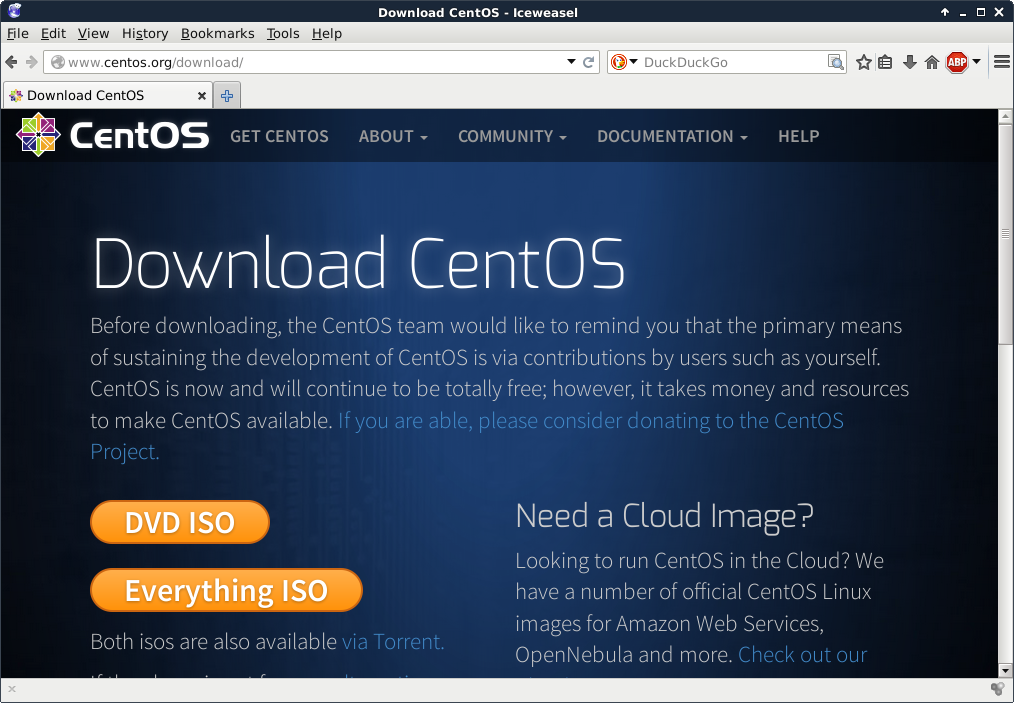Centos 7 Download Iso
As of end-March 2015, the second CentOS 7 release tagged as 1503 (CentOS 7.1) is available for download and CentOS 7.2 that was tagged as 1511 was released on 14 December 2015. The latest release supersedes all previously released content for CentOS 7, therefore it is recommended for all users to upgrade their CentOS machines. How to download CentOS 7 ISO Image: Use the following links to download the latest CentOS 7 ISO images from CentOS official download page or its mirror pages. CentOS project team finally released CentOS 7 for 64 bit x86 compatible systems. This is the first major release for CentOS 7 and actual version.
This repository contains all the instructions and code to build a Live ISO based on CentOSwhich can be used by minishift as an alternative tothe boot2docker ISO.
(CentOS mainly changes packages to remove upstream vendor branding and artwork.) CentOS is a distribution built from the source code of Red Hat Enterprise Linux. The CentOS project has announced the availability of a new update to the distribution, releasing CentOS 7-1708 which is derived from Red Hat Enterprise Linux 7.4. Welcome to LinuxQuestions.org, a friendly and active Linux Community. You are currently viewing LQ as a guest. By joining our community you will have the ability to post topics, receive our newsletter, use the advanced search, subscribe to threads and access many other special features.
- Building the CentOS ISO
- On CentOS-7
- On hosts other than CentOS-7 (OS X, Windows, Fedora ...)
- Releasing Minishift CentOS ISO
CentOS 7.5 Build 1804 ISO and CentOS 6.10 ISO Free Download includes all the necessary files to run perfectly on your system, uploaded program contains all latest and updated files, it is full offline or standalone version of CentOS 7.5 Build 1804 ISO and CentOS 6. Download CentOS 7.7 Net Install (NetInstall) image. Select mirror here: CentOS 7.7 x8664 version. Select ISO image CentOS-7-x8664-NetInstall-1804.iso. Note: only 64-bit (x8664) image is available. Burn CentOS 7 Image to CD and Boot Computer or Create Bootable USB Stick. The same steps will work on private or public cloud virtual machines too. CentOS is a stable Open Source Linux distribution and one of the most popular Linux platforms based on Red Hat Enterprise Linux (rhel) sources. The typical installation of CentOS as performed in this tutorial will be based on the CentOS 7 DVD ISO image.
Building the CentOS ISO
The following contains instructions on how to build the default (CentOS7 based) ISO.If you are able to install livecd-toolsdirectly on your machine, you can use the CentOS instructions.

If you don't have livecd-tools or using different linux distro other than centos, follow thehosts other than CentOS-7 instructions.
On CentOS
Prerequisites
Update your system before start and if there is kernel update then reboot your system to activate latest kernel.
Note: We use to have docker installed on system to get selinux context, check bugzilla
Centos 7 Download Iso Image
Building the ISO
On hosts other than CentOS-7 (OS X, Windows, Fedora ...)
Prerequisites
Building the ISO
Building the RHEL ISO
The Makefile also allows you to build a equivalent ISO based on RHEL insteadof CentOS. However, it requires you to have Red Hat VPN access and you need to exportseveral environment variables prior to building:
Releasing Minishift CentOS ISO
The following sections describe how to release Minishift CentOS ISO either via automated job or manually.
Manual release
The manual release includes following steps:
Assemble all the meaningful changes since the last release to create release notes.
Bump the
VERSIONvariable in the Makefile.Before you execute below command be sure to have a Github personal access token defined in your environment as
GITHUB_ACCESS_TOKEN.Run following command to perform release:
Automated release
Centos 7 Download Iso Free
An automated release can be performed by triggering CI job as:
where
api-key: Minishift CentOS CI API keyversion: The expected release version (without 'v'). For example, 1.0.0.
Once triggered you can follow the release process here.
The automated release performs all the necessary steps as mentioned in Manual release.
Tests
Tests are written as a shell script in tests/test.sh.
Note: Running the tests in Windows OS is unsupported.
Build ISO
Setup your build environment by following the instructions provided in Building the CentOS ISO section as per your preferred OS.
Note: Building ISO might require you to have Vagrant environment if you are not using host other than CentOS.
Run the tests:
Once the ISO is built from above step, use following command to run tests:
Note: If you are using the Vagrant environment, you need to exit from it and come back to host to run the above command.
This command will fetch the latest Minishift binary and run the tests.
CI Setup
minishift-centos-iso uses CentOS CI as CI build server.It builds incoming pull requests and any push to master along with archiving the build artifacts.You can find the CentOS CI jenkins master job here and the pull request job here.
Centos 7 Download Iso File
On a successful pull request build, the build artifacts can be found atartifacts.ci.centos.org/minishift/minishift-centos-iso/pr/<PR ID>.
On a successful master build, the build artifacts can be found atartifacts.ci.centos.org/minishift/minishift-centos-iso/master/<BUILD ID>.
For more information about CentOS CI, check out its Wiki toknow more about CentOS CI.
Further reading
Once you are able to build the ISO, you are most likely interested to modify theimage itself. To do so you have to get familiar withpykickstart.
Community
You can reach the Minishift community by:
Signing up to our mailing list
Joining the
#minishiftchannel on Freenode IRC